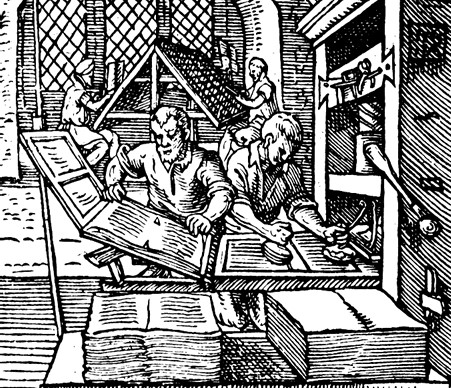The Reformation Led to the Translation and Printing of the Bible into the Peoples’ Common Languages

Gutenberg Press
The Reformation in Europe notably led to translations of the Bible into the people’s common languages so that ordinary people, not just clergymen, could read and understand it. Further, with the invention of the printing press by Johannes Gutenberg in Germany around 1440 just prior to the Reformation, Bibles could be affordably mass printed.
John Wycliffe, known as the “morning star of the Reformation,” wrote the first English translation of the Bible in 1384. Following Wycliffe and influenced by reformer Martin Luther who translated the Bible into German, William Tyndale wrote the first modern English translation of the New Testament in 1526. Tyndale was executed for doing so, but his work remained. Drawing from the work of Tyndale and Luther, Miles Coverdale produced the first modern English version of the full Bible in 1539, called the Great Bible, authorized by Henry VIII of England.
In 1560, protestant reformers including John Calvin, Theodore Beza, and John Knox who were exiled in Geneva, Switzerland, created a new English translation of the Bible called the Geneva Bible. The Tyndale and Coverdale translations contributed to this version. Easy to read and affordable, the Geneva Bible was accessible to English-speakers and mass printed. It became the most popular edition of the Bible among English-speaking Protestants until the mid-1600s. This Bible was, in fact, studied by the Pilgrims who brought it to America in 1620. The unique feature of the Geneva Bible was its marginal notes and commentaries. These notes presented the Reformed Theology that challenged absolute power, including the power of the king. As a result, this Bible was rejected by King James I of England and the moderate Church of England.
King James called for a new Bible to be translated without such marginal notes. The King James Bible came out in 1611 and became the authorized Bible of the Church of England. Many clergy preferred this Bible for its more moderate tone. Puritan leader John Winthrop brought the King James Bible to America in 1629. By the late 1600s and 1700s, the King James Bible would become the most widely read Bible in the American colonies.
The Reformation and printing press modernized the Western world by making the Bible and books readable and available to the broader masses of people in Europe, America, and the world. These events, in turn, led to a more widely literate and enlightened population who read and knew the Bible. With such knowledge, the people could discern Biblical teaching and truths for themselves.
Contributed by AHEF and Angela E. Kamrath.
Source: Kamrath, Angela E. The Miracle of America: The Influence of the Bible on the Founding History and Principles of the United States of America for a People of Every Belief. Second Edition. Houston, TX: American Heritage Education Foundation, 2014, 2015.
Related Blogs/Videos:
1. The Context of the Protestant Reformation
2. The Igniting of the Protestant Reformation – Martin Luther’s 95 Theses
3. The Key Tenets of the Protestant Reformation
4. The Key Political Thinkers & Writings of the Reformation Era
5. The Catholic Counter-Reformation
6. Three P’s That Led to Freedom in the West: Printing Press, Protestant Reformation, & Pilgrims
Activity: Miracle of America High School Teacher Course Guide, Unit 1, Part 1, Activity 5: Photo Story Unit Project, pp. 56-57. HS.
To download the whole unit, sign up as an AHEF member (no cost) to access the member resources page on americanheritage.org.
Copyright © American Heritage Education Foundation. All rights reserved.

